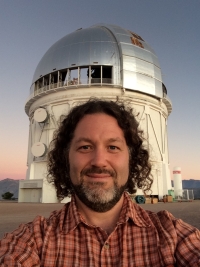Dr. Gregory Rudnick
University of Kansas

The life cycle of galaxies in clusters over 10 billion years
102 Cardwell Hall
February 26, 2018
4:15 p.m.
Galaxies are gravitationally bound structures containing atoms in the form of stars, gas, and dust, and dominated gravitationally by Dark Matter. They are fed by filaments of matter that supply them with new gas from which they form stars. Galaxies can interact with each other and with their surroundings, both via gravitational tidal forces and via hydrodynamic forces that can truncate their gas supply or actively remove the gas from their gravitational potential wells. Galaxies live in a range of environments, characterized by the density with which they are packed into the Universe. For example, the densest regions of the Universe are in galaxy clusters, which contain hundreds to thousands of galaxies all in pseudo gravitational virial equilibrium and surrounded by a hot and diffuse x-ray emitting gas. These dense environments can in turn alter the properties of the galaxies themselves in striking ways via a variety of gravitational and hydrodynamic processes. The result of these processes alter galaxy shapes, the internal motions of their stars and gas, and can shut off the formation of new stars. I will present work I have been doing to characterize the evolution of galaxies in clusters over the past 10 billion years as a way of understanding how the environment can affect galaxies. I will describe how we have used an extensive multi-wavelength data set on distant clusters from the ESO Distant Cluster Survey (EDisCS) to form a picture in which infalling cluster galaxies likely have their gas supplies cut off, their morphologies transformed, and may even experience epochs of very frequent mergers. I will also discuss new results on cluster galaxies 9.5 billion light years away that I am using to understand how the quenching of star formation in massive cluster galaxies proceeds at the epoch when they began their final cessation of star formation.
